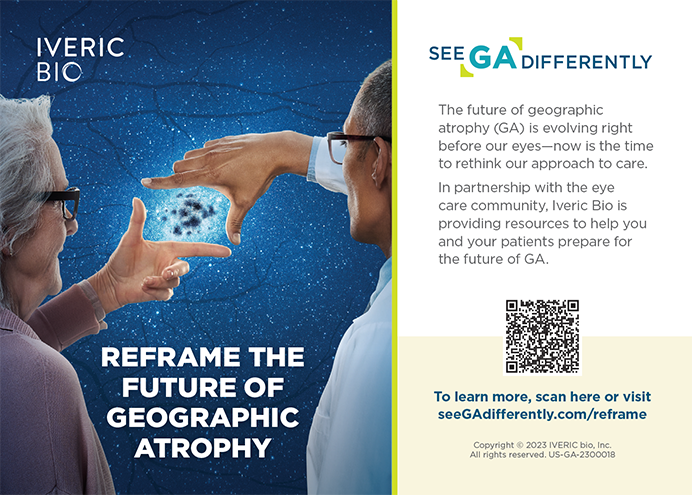

Characteristics of Ocular Findings of Patients With Coronavirus Disease 2019 (COVID-19) in Hubei Province, China
Wu P, Duan F, Luo C, et al1
Industry support: No
ABSTRACT SUMMARY
This retrospective case series evaluated 38 patients with clinically confirmed COVID-19 who were treated in the Chinese province of Hubei between February 9 and 15. The investigators collected information on ocular signs and symptoms as well as the reverse transcriptase polymerase chain reaction (RT-PCR) results of both conjunctival and nasopharyngeal swabs. They found that approximately one-third of patients (31.6%) had ocular symptoms, including conjunctivitis, conjunctival hyperemia, chemosis, epiphora, and increased ocular secretions. Overall, ocular symptoms were more common in patients who had more severe disease and more severely deranged blood counts. Although 73.7% of patients had positive nasopharyngeal RT-PCR results for severe acute respiratory syndrome coronavirus 2 (SARS-CoV-2), only two patients (5.2%) had positive conjunctival swabs. Both patients with positive conjunctival swabs exhibited ocular symptoms.
Study in Brief
This retrospective case series evaluated ocular symptoms and manifestations in 38 patients with COVID-19 who were hospitalized in China.
WHY IT MATTERS
Severe acute respiratory syndrome coronavirus 2 (SARS-CoV-2), the virus responsible for COVID-19, was first reported in a cohort of Chinese patients in December 2019. At this time, little is known about SARS-CoV-2, including whether it leads to ocular manifestations. This case series describes ocular findings in a small subset of patients who tested positive for SARS-CoV-2.
DISCUSSION
Let’s take a closer look at some of the points of the study and its limitations.
What is the relationship between the ocular manifestations of the virus and severity of COVID-19? Of the 12 patients with ocular manifestations of the virus, half were judged to be critically ill based on clinical guidelines. Univariate analysis showed that patients with ocular symptoms were more likely to have higher white blood cell and neutrophil counts and levels of procalcitonin, C-reactive protein, and lactate dehydrogenase compared to patients without ocular symptoms. These results suggest that ocular manifestations of the virus may be more common among patients with severe disease.
Can SARS-CoV-2 be transmitted through ocular secretions? This study found SARS-CoV-2 within conjunctival secretions via RT-PCR, albeit in a minority of patients. Despite the relatively low incidence, these results suggest that the virus could be transmitted through ocular secretions. Additional research is warranted to investigate this link further.
What are the limitations of this study? This study had a small sample size of 38 patients. None of the patients underwent a detailed ocular examination, meaning that all ocular findings were limited to external signs and symptoms and that data on potential intraocular or microscopic findings were not investigated.
Utility, Appropriateness, and Content of Electronic Consultations Across Medical Subspecialties: a Cohort Study
Ahmed S, Kelly YP, Behera TR, et al2
Industry support: No
ABSTRACT SUMMARY
This retrospective cohort study sought to assess the utility and appropriateness of electronic consultations (e-consults) among primary care and specialty practices within a single integrated health system comprising both academic and community medical centers. Specifically, five specialties were included: hematology, infectious disease, dermatology, rheumatology, and psychiatry. Of 6,512 eligible e-consults, 750 were randomly selected for review. Four reviewers, each of whom worked independently, assessed the appropriateness of the consultation based on four predefined criteria: point-of-care resource test, logistics only, urgency, and complexity. The utility of the e-consult was determined by avoided visits, which were defined as the lack of an in-person visit to the same specialty within 120 days.
Study in Brief
A retrospective cohort study assessed the appropriateness and utility of electronic consultations (e-consults) among five specialties within a single integrated health system. A majority of the e-consults met all required criteria for appropriateness, and the rate of avoided visits—a measure of the consultations’ clinical utility—was 81.2% across all of the specialties.
WHY IT MATTERS
Access to specialty medical care varies greatly based on geographic location, and it is often reduced by time (ie, availability of patients and physicians), scheduling constraints, and limited financial and logistical support. Prior studies have suggested that e-consults could improve patient access to specialty care, reduce waiting times, and enhance physician–physician communication and education. The metrics evaluating the effectiveness of these services, however, have been limited. The COVID-19 pandemic has heightened the relevance of this topic because telemedicine options such as e-consults could improve health care access and safety for patients and providers alike.
Demographic data were similar across specialties, with some minor exceptions. Most e-consults were completed within 1 day. Questions regarding therapy and diagnosis were the most commonly asked at 49.9% and 46.2% of e-consults, respectively. Although there was variation by specialty (60.5% rheumatology, 68.5% infectious disease, 70.7% dermatology, 73.3% hematology, 77.9% psychiatry), 70.2% of e-consults overall were rated as appropriate. Interrater agreement regarding the defined appropriateness criteria was moderate (K = 0.57 [95% CI, 0.36–0.79]). The most common reasons that an e-consult was deemed to be not appropriate were asking a question of inappropriately high complexity and failing the point-of-care test result, meaning a point-of-care resource that answered the question was widely available to the referring doctor.
DISCUSSION
Let’s take a closer look at some of the points of the study and its limitations.
What is the key learning point? It is important to define and assess the appropriateness and clinical utility of e-consults via clearly defined criteria. Ahmed and colleagues found high rates of utility—measured as avoided visits—and appropriateness among the specialties that they evaluated.
What applications does this study have for eye care? Although this study does not directly investigate the clinical utility of e-consults for eye care, providers in this field have similarly busy schedules and cannot spend time on a program that includes high rates of inappropriate consultations. Of the specialties included in this study, dermatology offers the most direct comparison because both fields require a high degree of visual inspection for examination. Dermatology had a 70.7% appropriateness rating but also the lowest rate of avoided visits (61.9%). Although this represents a majority of the patients, the lower rate of avoided visits may be because of the visual nature of dermatology.
The e-consults included in this study were strictly questions and did not include photographic documentation. The inclusion of patient images might have produced different results for a visual specialty such as dermatology. E-consults would pose unique challenges for eye care providers because these e-consults do not permit slit-lamp or dilated fundoscopic examinations. Nor could testing such as IOP checks or imaging be performed. Regardless, this study illuminates the usefulness of e-consults and validates that they deserve further exploration for wider implementation in eye care.
What are the main limitations of this study? This study was conducted within an integrated hospital system with providers who shared a common electronic health record that had been in use for several years. The results are therefore not immediately generalizable to a group just getting started with e-consults that would inevitably experience growing pains. The applicability of these findings to physicians communicating across different electronic health record systems and/or e-consult platforms is unknown.
Additionally, provider satisfaction with the e-consult system was not assessed. Moreover, the study focused on urban centers with mostly white patients. Data therefore may not be generalizable to rural settings or minority populations. This study also does not provide information on concurrent use of e-consults with patient images such as those often received in ophthalmology.
1. Wu P, Duan F, Luo C, et al. Characteristics of ocular findings of patients with coronavirus disease 2019 (COVID-19) in Hubei Province, China [published online ahead of print March 31, 2020]. JAMA Ophthalmol. doi:10.1001/jamaophthalmol.2020.1291.
2. Ahmed S, Kelly YP, Behera TR, et al. Utility, appropriateness, and content of electronic consultations across medical subspecialties: a cohort study [published online ahead of print April 14, 2020]. Ann Intern Med. doi:10.7326/M19-3852.




